Uninterrupted water supply to the house directly depends on the quality of the pump used. This device is the "heart" of hydraulics, and must have sufficient output characteristics. Professionals prefer to make a selection of a downhole pump with a small margin of power, which ensures that it does not operate at full load.
Criterias of choice
In addition to the dimensions of the device, they are guided by physical indicators hydraulic system consisting of the following indicators:
- optimal pressure;
- coefficient of pressure loss during liquid transportation;
- differential pressure when the water pump is turned on or off;
- maintainability and comfortable operation.
Another popular criterion is the cost of equipment. There are devices from different manufacturers on the market. Legal products always have a quality certificate. Popular trade marks- Sprut, Aquarius, Wilo, Hydro-vacuum.
Household appliances used at home are powered by single-phase electrical networks. For work in industrial conditions, a well pump is selected from three-phase models.
Popular models
The inner diameter of the well imposes restrictions on the dimensions of submersible installations. Devices for consumers are offered in two formats:
- three-inch (on the outer belt does not exceed 75 mm);
- four-inch (outside limited to 100 mm diameter).
The first option is universal, and is suitable for most wells, but has a lower output power. Pick up a pipe for it at least 89 mm. In the second case, the casing pipe is limited to 114 mm in inner diameter.
The following popular models fall under the described dimensions:
- for 4 inches Aquarius (up to 105 mm);
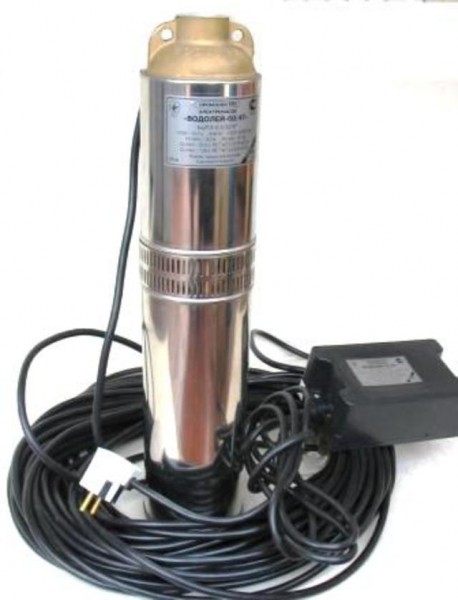
- for 4" Pedrollo 4BLOCKm (up to 100mm)
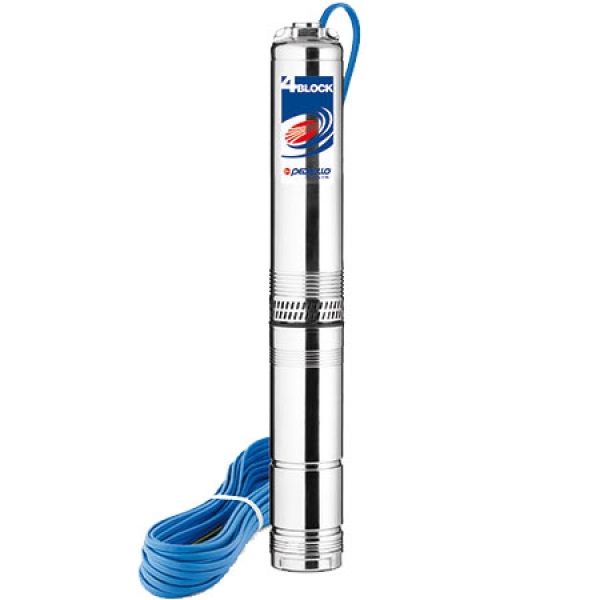
- for 3" Grundfos SQ (up to 75 mm)
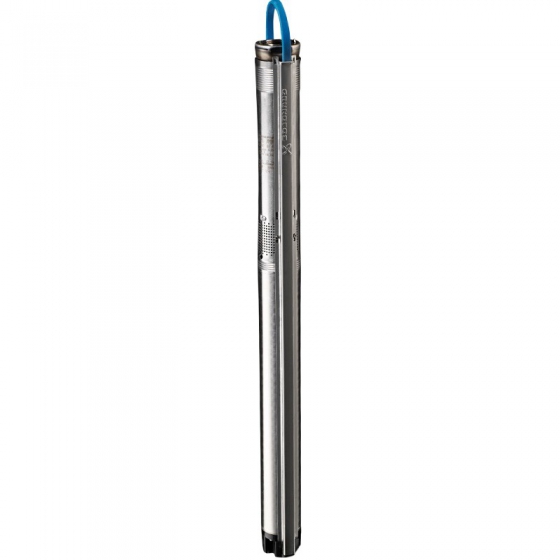
When selecting a pump for a well according to the parameters, it is worth considering the immersion depth of the apparatus. The vast majority are limited to the 50 meter mark. An example is SAER, equipped with "floating" impellers. An additional node serves as protection against "dry running", and it is also customary to install a system that minimizes voltage drops.
How to choose a voltage stabilizer
The main feature of the equipment operation is high starting currents - during switching on, its power increases by a multiple, due to which it exceeds the operating currents by at least 4 times. At the moment of switching on, the voltage in the network drops sharply, which makes the unit work at its limit. And this process is repeated every time it needs to be turned on to pump water. In addition to the fact that the unit itself operates at the power limit, wears out faster, and all other electrical appliances connected to this moment, do not cope. This is especially fraught with refrigerators and TVs that are constantly connected to the network.
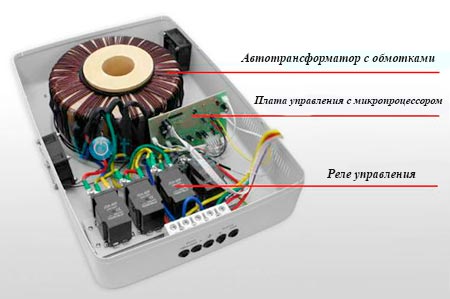
Relay Voltage Stabilizer
The best solution would be to install a voltage stabilizer, which will create a normal mode of operation and bring the equipment out of stress mode.
Most main parameter, which must be taken into account - the magnitude of the starting current and motor power. This indicator, as a rule, is reflected in the technical documentation (product passport), but you can calculate it yourself.
We take for the original domestic pump Water cannon 60/92 power P = 1100 W.
IU= P: 220 V x 0.8
- where IU is the value of the operating current;
- P is the power of the equipment;
- 220 V - voltage in the network;
- 0.8 is the power factor (0.8 cos f).
1100 W / 220 V x 0.8 = 4 A
Accordingly, the operating current of the Water Cannon is 4 Amps. To determine the starting current value, the value obtained must be multiplied by 4 (standard multiple of starting).
The value of the starting current of the Water Jet 60/92 with a power of 1100 W will be 16 amperes. This indicator corresponds to a voltage regulator with a power of 5000 VA.
For those devices that are equipped with an electric motor, voltage regulators with relays, which are characterized by maximum speed, will be much more rational.
For borehole pumps, it is necessary to choose voltage stabilizers with relays (relay).
Carrying out calculations
It is not worth buying a deep installation in advance, since the physical values of the well are not yet known. First of all, you need to get a passport for it, make a calculation, and only after that will it perform a competent selection according to the initial parameters.
It is customary to build on:
- the number of points of parsing, which include water taps, drain barrels, dishwasher or washing machine;
- number of users who constantly or systematically use water;
- the need for water is influenced by the lifestyle of the owners and seasonality.
During the summer time there are peak loads for fluid consumption. This must be taken into account in advance, since subsequently it will not be possible to increase the power of the pump, it will only have to be changed.
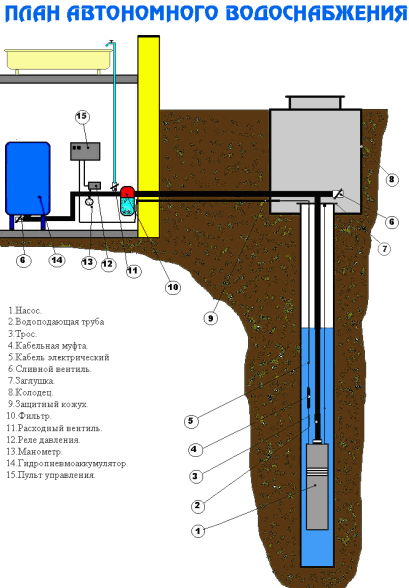
The main formula for the calculation includes several important parameters described in the well certificate:
- Debit. The indicator affects the performance of the equipment. It demonstrates the volume of liquid that the well can provide the consumer for a limited period of time (cubic meters / h);
- Hole diameter and depth. The values allow you to select the unit model according to the external dimensions and limit the head level calculated in m.
- static level. Depth to the surface of the water when the pump is not running, when there is no pumping.
- dynamic level. Depth to the surface of the water during pumping. It limits the lowering height of the equipment.
- Filter node parameters. A casing pipe is mounted inside the shaft, on the lower part of which a column with a perforated section is installed.
Be sure to take into account the distance to the residential building in which the hydraulic equipment is installed.
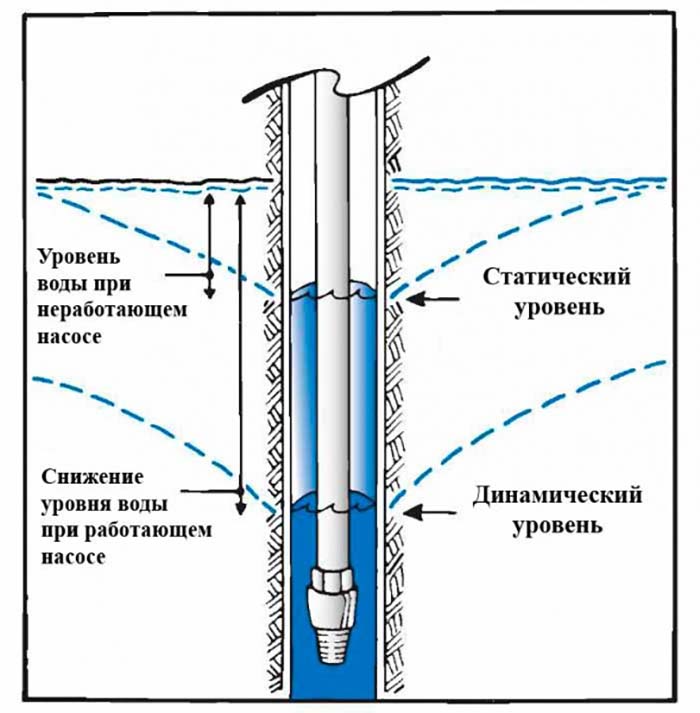
In the presence of a casing pipe, the choice of equipment is much wider. In particular, this applies to vibration, which emits significant vibration during operation, which leads to subsidence of rocks and siltation of the mine.
Calculation example
As a guideline, we take two-storey house with a couple of toilets, a kitchen and one washing machine. It is believed that four people live in it.
The well has the following parameters:
- depth 65 m;
- debit 3.5 m;
- diameter 122 mm;
- dynamic level 35 m;
- static level 20 m;
- a house with a hydraulic accumulator is removed from the well at a distance of 12 m, which will reduce the pressure by 1.2 m in height;
- ceilings in the room are 3 m.
Calculations can be made using online services, but they may not always take full values into account. It is preferable to perform the operation yourself.
- We determine the performance of the borehole pump, focusing on the debit and the maximum value during the analysis of water. Let's assume that all consumers are active. We summarize the standard indicators based on the expense table. As a result, we get the required performance with the shower, washing machine, toilet and sink running:
0.7 + 0.7 + 0.4 + 0.7 \u003d 2.5 m 3
The next step should be to calculate the pressure. For the operation, you need a standard formula:
H w = P s x 10.2 + hi
- Ps - the required pressure in the plumbing system, usually 2-3 atm;
- 10.2 - constant coefficient;
- hi is the total head calculated from the available values of the well and distance, m;
h i = i1 + i2 + i3 + i4 + i5
- i1 - dynamic level value;
- i2 - distance from the building;
- i3 - rise to the highest point of water intake;
- i4 - required pressure at maximum height, take 2.5 m;
- i5- technical losses pressure, takes 2 m.
h i \u003d 35 + 1.2 + 4.5 + 2.5 + 2 \u003d 45.2 m
H w \u003d 2.5 x 10.2 + 45.2 \u003d 70.7 m
- Based on the results of calculations, the following parameters for the future unit were obtained:
- The performance of the device must be at least 2.5 m 3 / hour. Given the existing well flow rate, it is worth choosing a device with greater productivity, as the available values allow it. For this situation, an indicator of 3.5 m 3 / hour will be optimal.
- The calculated head is 70.7 m. This value is the minimum allowable. Manufacturers of deep installations indicate it in the instructions and on the case.
- Based on the diameter of the shaft, we select the device up to 100 mm in diameter. It is obligatory to have a gap between the pipe and the body of the apparatus.
- You can lower the machine to a depth of 40-45 m. This criterion is also involved in choosing a deep installation.
All calculations are based on the fact that the fence is carried out at the working point. This area allows the device to function without overload, with maximum efficiency.
Additional equipment
For correct operation systems will have to stock up membrane tank to balance the pressure drops in the system. It is important to start up the entire electrical part through the electronic control unit. Pressure control is carried out by means of analog sensors, pressure gauges.
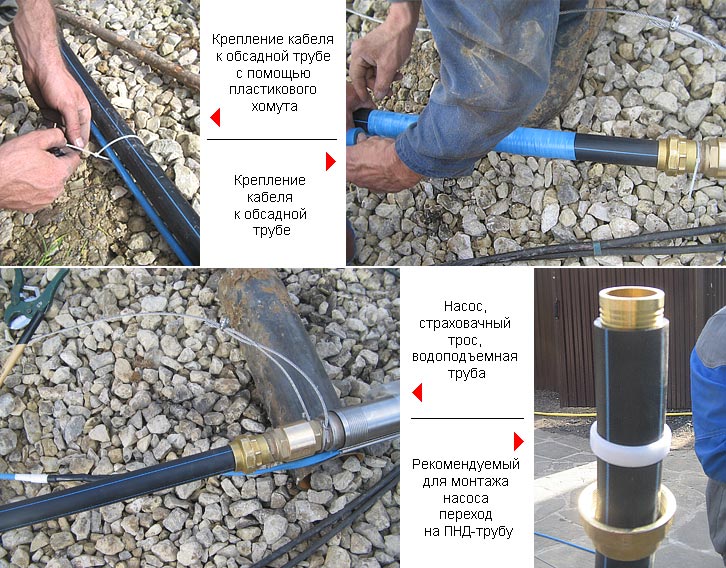
The pump is hung in the shaft on a steel cable, closed insulating material. Connections are made using adapters and clamps made of of stainless steel or hard plastic. The supply cable is selected depending on the power of the connected unit. Don't have to choose single phase pumps high power. They need starting currents many times higher than the nominal values. Then you have to mount a powerful stabilizer, the cost of which will not justify.
The basis of performance is the correct combination of all device parameters. You should not buy more powerful equipment than specified in the calculations, as it will not match the debit of the mine. Even if there is a large number water during operation, an emergency situation will constantly arise when it falls below the operating point due to the power of the unit. Of course, a high-quality pump is equipped with protection against dry running, but it may not always work in a narrow hole, and then the device burns out within 5-6 minutes.
But even the purchase of a low-power device is unlikely to satisfy all the needs for water, since its indicators will simply not be enough. The relevance of the "golden mean" in terms of performance and price has not yet been canceled.
VIDEO: Selection of a borehole pump by parameters
For efficient water supply country house it is necessary not only to make a well, but also to equip the underground structure with the necessary equipment, the main component of which is a device for lifting water from depth to the surface. Proper selection of a borehole pump will ensure uninterrupted water supply in the cottage and reliable operation of the equipment itself. What criteria are guided by when choosing a pump for a well, and what characteristics of the device will be decisive in this - these and some related questions will be answered in the article.
Types of pumps for lifting water to the surface
Now there are several types of pumps that are used to pump liquids from deep. The main ones among them are:
- superficially installed;
- submersible vibration;
- submersible centrifugal (rotary).
The first type of equipment is characterized by the fact that the mechanism is on the surface, while an attached pipe (hose) is placed in the water, through which water is sucked in. Surface-mounted pumps have a limited liquid lifting depth (up to 9 meters), so they cannot be considered as full-fledged downhole equipment. With the help of such devices, it is possible to raise liquid only from surface aquifers (perch waters), where the quality of water is suitable only for irrigation.
Submersible vibration pumps, which work due to the movement of the membrane and the valve system, are structurally simple, inexpensive and can pump water from a depth of up to 30-40 meters (depending on the power of the model). However, it is categorically not recommended to install such equipment in aquifer deep wells for several reasons:
- strong vibration destroys the well structure;
- the strong turbulence that occurs during operation raises silt and sand from the bottom of the water mine, which pollute the water;
- form vibration pumps not adapted for use in narrow casing pipes, so the device often gets stuck in them, after which it is necessary to carry out expensive repair and restoration work.
In a word, vibratory type equipment is not intended for use in wells, so it makes no sense to try to use it for other purposes. Such products successfully work in Abyssinian wells, pools, and other wide water reservoirs.
In water-bearing wells of medium and large depth, only rotary type equipment is used. Centrifugal submersible pumps are specifically designed to work in narrow wellbores and, if properly maintained, last 10 to 20 years. What is this type of device, we will consider further.
Rotary borehole pumps
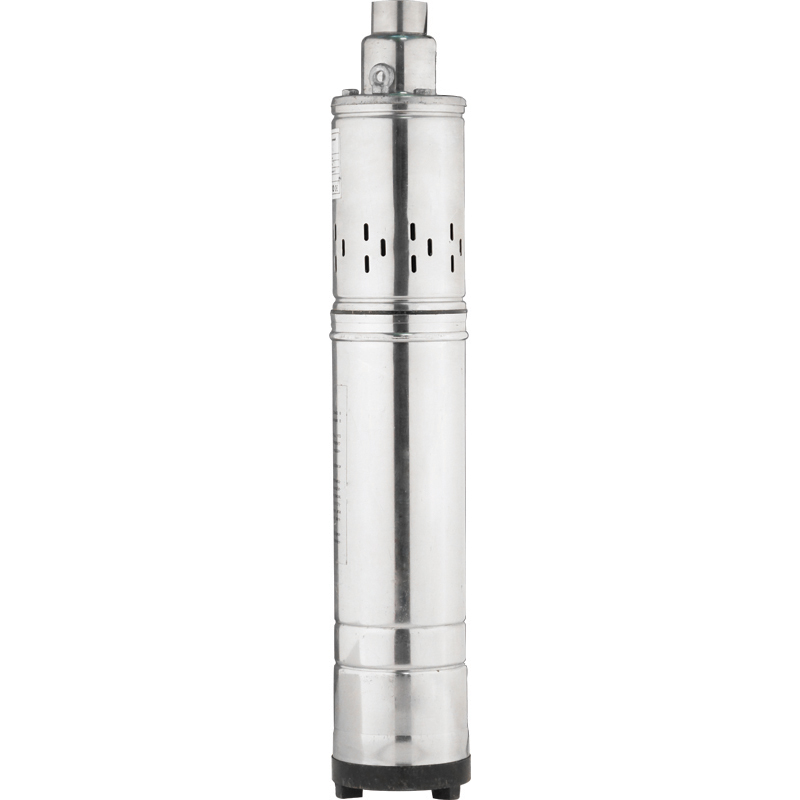
Such devices have an oblong cylindrical shape, specially designed for ease of installation and excavation from a narrow barrel casing. It is characteristic that such devices do not suck up water on their own, the liquid flows into the body by gravity, where it is picked up by a rotating wheel and twisted. Under the action of centrifugal force, water is thrown out to the outlet pipe located at the top center. This feature of rotary pumps puts forward certain requirements for their installation. It is important to place the devices in such a way that there is always a water column of at least 1 meter above them, which would facilitate the arbitrary flow of liquid into the housing through the inlets.
Second feature centrifugal pumps, - the need for their constant cooling, which is due to the very high rotational speed of the motor shaft. Even the presence of high-quality grease in the bearings does not protect the pump from overheating. The cooling substance during the operation of rotary equipment is also water. Without it, the pump fails within a few minutes. This circumstance also puts forward the requirements for immersion of the device to the required depth, wherever the pumping equipment under any operating conditions always remains in the water column.
Important! Most models of modern rotary pumps are equipped with automatic overheating protection that turns off the motor if there is not enough liquid around the device. This allows you to greatly extend the operational period of products.
Thus, only centrifugal-type equipment is downhole, so the choice should fall on them. It remains to determine the parameters of the required device and their compliance with the characteristics of a particular well.
Downhole pump parameters
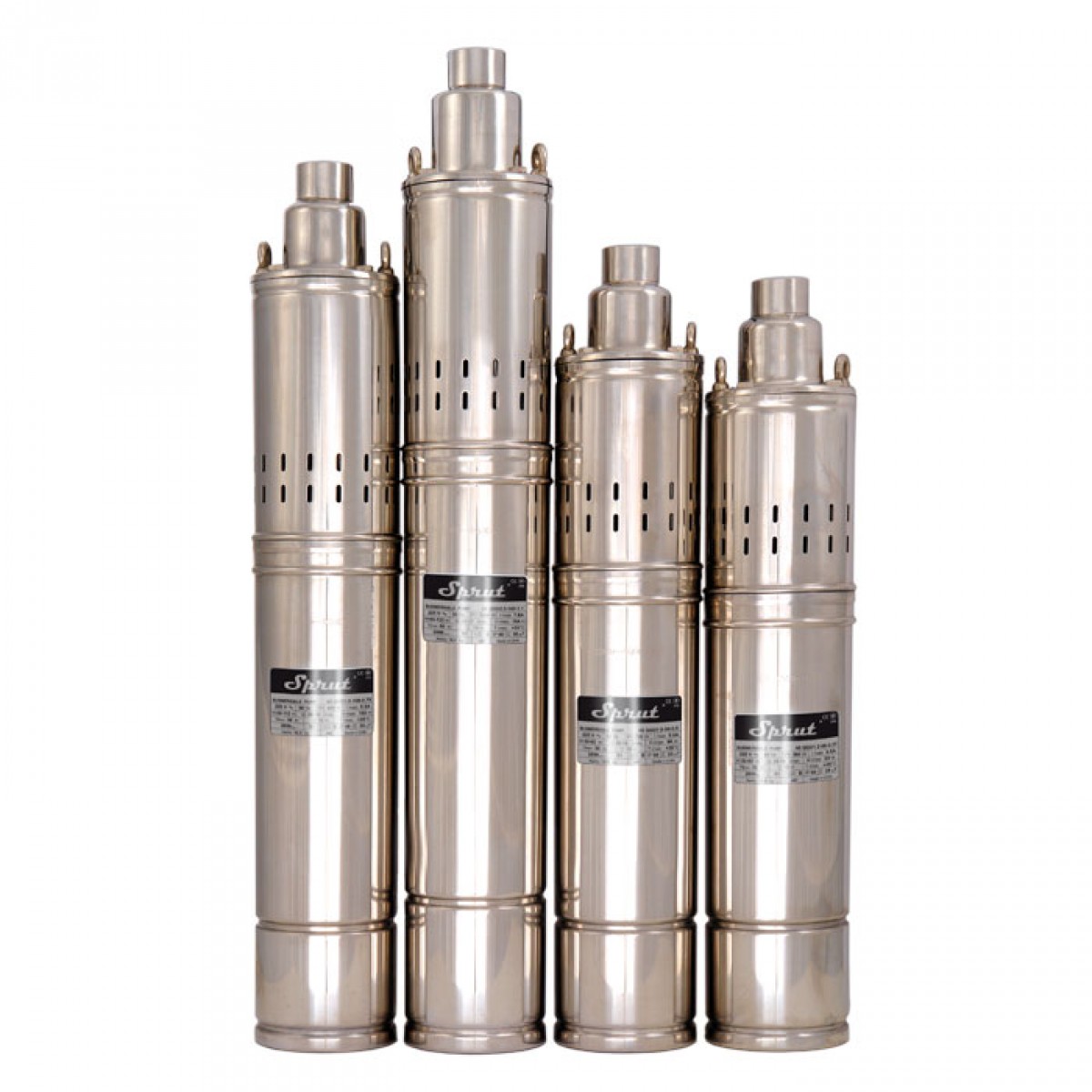
Pumping equipment designed to work in deep wells has the following technical characteristics that determine the choice:
- power (pressure);
- consumption (performance);
- body diameter.
The first indicator characterizes the force with which the device pushes the liquid. The greater this force, the greater the height of the column of ejected water will rise. This indicator characterizing the equipment is called pressure and is measured in meters of water column.
Pump flow or performance (they are one and the same), shows how much liquid the device is able to pump over a certain period of time. The capacity is expressed in m3/h or liters per minute.
It is important that the cylindrical pump casing freely enter/exit the casing, therefore, when choosing, be sure to pay attention to the diameter of the casing and correlate it with the same indicator (internal) of the casing.
Little things, but important, when choosing downhole equipment are such things:
- length and section of the electric cable;
- length and strength of the retaining cable;
- storage tank volume.
Still, the most significant are the parameters of the pump itself and their compliance with the characteristics of a deep well.
What indicators characterize the well?

For right choice equipment, some data characterizing a deep well should be evaluated. Interested in such well parameters:
- dynamic water level;
- well debit;
- casing inner diameter.
In addition, when choosing a pump, you will need data on the level of the highest point of water consumption in the house and the distance of the main building from the well.
The first two indicators can be found in the passport of the underground structure. The dynamic level indicates the height of the water table in the casing during long-term water intake. The pump is installed at least one meter below the dynamic level. From this it is necessary to proceed, calculating the height of the rise of water to the level of the mouth of the well. The debit indicates the rate of fluid replenishment in the lumen of the well. These data are needed when choosing the performance of pumping equipment. Knowing the diameter of the casing pipe will help not to make a mistake with the choice of the appropriate pump rating.
How is the required pressure determined?
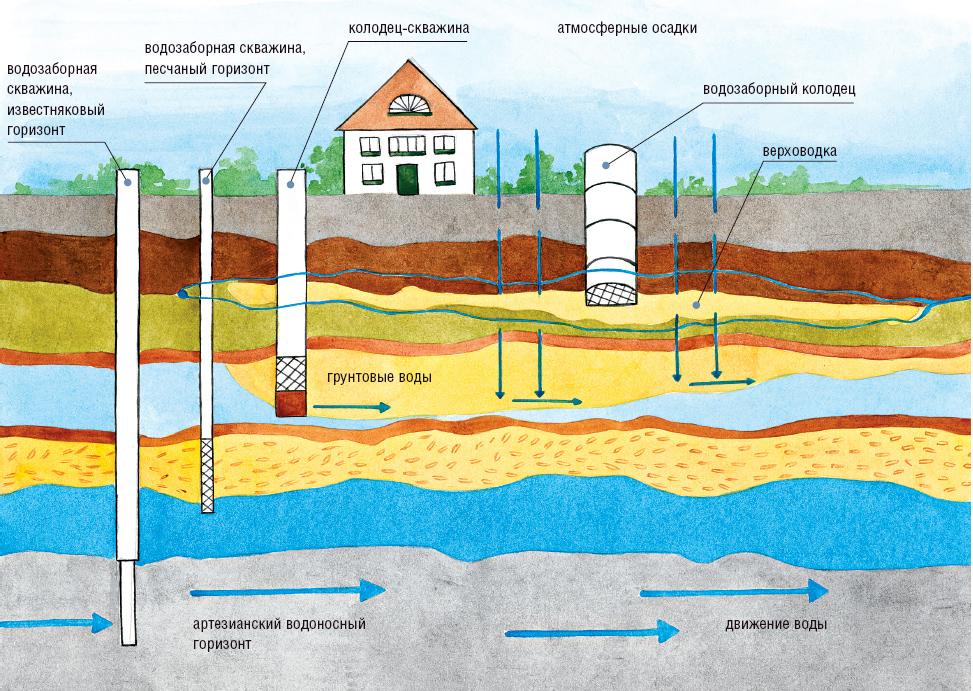
This is the most important indicator of pumping downhole equipment. If you choose a device with insufficient pressure, the water simply will not reach the point of intake. Too much powerful pump will run half empty, which will lead to premature wear. So it is important to calculate the required pressure, close to the ideal indicator.
How are the calculations made? To do this, the following data is summarized:
- installation depth of the pump relative to the mouth (head);
- height of the extreme point of water intake;
- the distance from the house to the well, divided by 10;
- overpressure(needed to create head at the points of water intake), which is equivalent to approximately 20 m of head.
The resulting amount will be an indicator that you should focus on when choosing a device that is optimal in terms of power.
Performance definition
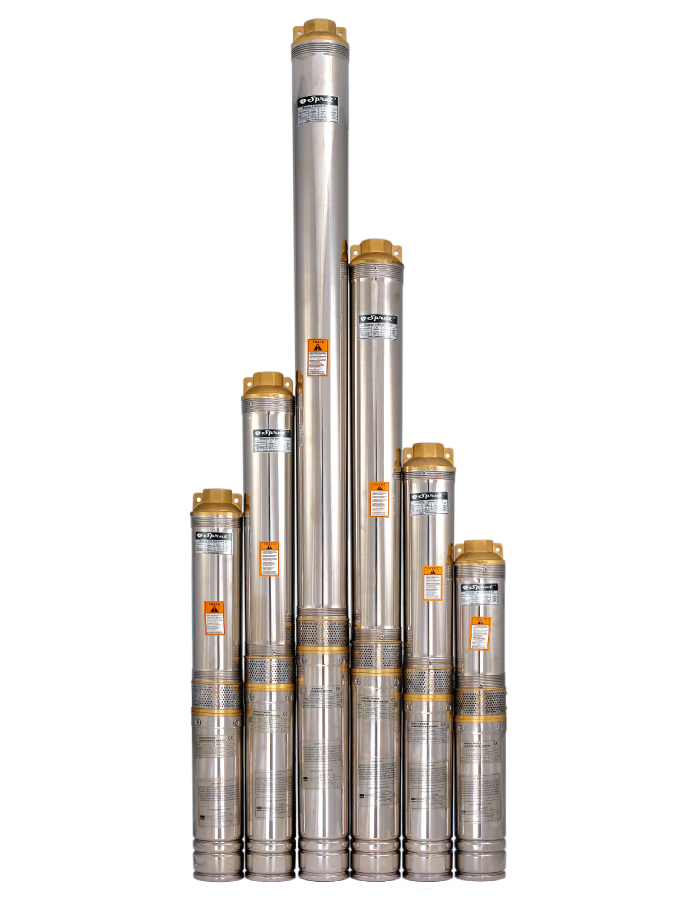
This indicator does not require complex calculations. The consumption of pumping equipment should not exceed the debit of a deep well. For example, if the inflow in the well is 3 m3, a pump capacity of 2.7 m3 per hour will be quite enough. It is not scary if the consumption of the device is, for example, 1.5 m3 per hour.
The main thing is not to purchase equipment whose performance is much higher than the debit of the well. During the operation of such a pump, a situation will constantly arise when the water level drops to the installation position of the suction device. If the latter is equipped with effective automatic protection, it will turn off the equipment. But you need to think that the protection may someday fail, not work, and the pump will burn out in a matter of minutes, running dry. Therefore, it is better not to risk an expensive device by making the right choice of its performance.
Important! It must be understood that the performance of a borehole pump will correspond to that stated in the product passport only with the right choice of pressure. If the power of the device is less than the calculated one, the performance will also decrease.
To set for the well necessary equipment, it must be chosen correctly. Numerous parameters are taken into account, including the calculation of water flow, the required pressure, power.
When selecting a submersible pump, it is necessary to focus on a pressure of 2.5 - 3 bar, at the highest point of the water intake.
An important criterion for deep pumps is which cable will be used for them. The selection of a borehole pump is a responsible process, it must be taken seriously so that the equipment works correctly and for a long time.
What you need to know when choosing a pump?
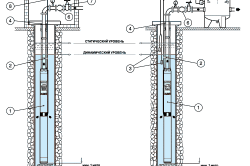
Scheme of installation of a borehole pump.
When choosing a pump, it is necessary to take into account such parameters as:
- The total depth of the well. This information is contained in the attached passport. It is customary to install the equipment at a height of 1 m from the bottom level.
- Dynamic water level. The pump must be placed below this level, it is also indicated in the passport. The static level is also important to consider.
- Borehole diameter for proper sizing deep pump, its adapter, head, covers for the wellhead.
- The flow rate is data on the productivity of the source, borehole pump should not have a productivity greater than that of the well. Ideally, the choice should be made in such a way that the productivity of the equipment is approximately 5-10% less than the flow rate of the source.
- Size, depth of the filtering part. The downhole pump must be positioned so that the motor is above the filter. Only in this case the system will work without failures.
- The distance from the house to the well. Not only the horizontal value is taken into account, but also the height to which the pipes rise.
- Floors, the location of the highest point of the water intake.
- The place where automation is installed to control the pump.
- A power supply option that powers the well pump.
General criteria for choosing a pump for a well in a suburban area:
- Equipment power. The selection of the unit depends on the depth of the source, the required pressure and the planned water flow for the house. You cannot make a selection without taking this parameter into account.
- The depth that the well has. This parameter is important for choosing a pump, many consider it one of the first. For example, surface pumps can only be used for shallow springs and wells, while only deep models are used for water wells.
- The choice is made on the basis of what the planned water flow will be, that is, what the pump performance should be.
Calculation of flow and pressure of water
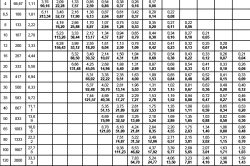
Well pump selection table.
The choice of pumping equipment should be carried out, taking into account the expected water consumption for the site and the house:
- for a shower - 0.2-0.7 l / s;
- for a jacuzzi - 0.4-1.4 l / s;
- for bath with standard mixers- 0.3-1.1 l / s;
- for sinks, sinks in the kitchen and bathrooms - 0.2-0.7 l / s;
- for taps with sprayers - 0.15-0.5 l / s;
- for the toilet - 0.1-0.4 l / s;
- for a bidet - 0.1-0.4 l / s;
- for a urinal - 0.2-0.7 l / s;
- For washing machine- 0.2-0.7 l / s;
- For dishwasher- 0.2-0.7 l / s;
- for watering taps and systems - 0.45-1.5 l / s.
To calculate the pressure, it must be remembered that the pressure in the pipes should be 2-3 atmospheres, and the excess pump power should not exceed 20 m. For example, the immersion depth is 10 m from the ground level, then the calculated loss will be 3 m. In this case the pressure is calculated as follows: well depth + water supply along a vertical shaft + height above the ground level of the upper draw-off point + overpressure + calculated losses. For this example, the calculation will be as follows: 15 + 1 + 5 + 25 + 3 = 49 m.
When summing up the approximate consumption per unit of time, one must also take into account the fact that 5-6 taps are opened at the same time or a similar number of draw-off points are used. The number of residents, the presence of greenhouses on the site, the garden and other parameters are taken into account. Without these data correct selection impossible.
How to choose a cable for a submersible pump?
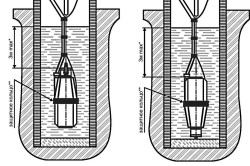
Scheme of permissible pump installation dimensions.
The choice of the pump is impossible without the selection of a cable for its fastening. Only a stainless steel product is chosen, as it is able to withstand not only the weight of the pump itself, but also the numerous equipment that is used to lift water up.
The length of the cable is taken with a margin, since they are used for fastening special hinges, they take 1-2 m each, plus it is necessary to leave a margin of 2-3 m. Clamps are used to fasten the cable.
When choosing a cable, the following values \u200b\u200bare taken into account:
- for a diameter of 2 mm, the static load is up to 100 kg;
- for a diameter of 5 mm, the static load is up to 650 kg.
It is important, when choosing a cable for the pump, to remember that when turned on, a jerk occurs, the load increases. If you buy a pump with a lot of weight and power, then it is best to take a 5 mm cable for it, which will perfectly withstand all conditions of use. When buying, it is taken into account that the total load includes:
- the total weight of the pump, the engine for it;
- own weight of the rope;
- the weight of water that rises through the pipe;
- weight of the power cable;
- total weight of fittings;
- the weight of the filtering equipment that is located under the pump.
What hydraulic accumulator is needed?
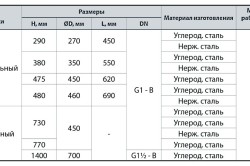
Hydraulic accumulator selection table.
For the correct choice of the pump, attention must also be paid to which accumulator will be used. Its purpose is to accumulate a certain amount of water to prevent the pump from turning on frequently.
When a certain volume of water is reached, the pump turns off until the water is used up. Each pump has a permitted number of starts per hour, which should not be exceeded.
Usually these are 20 starts, which, in the absence of a hydraulic accumulator, will be carried out each time the valve is opened. But if there is a tank, such inclusions will be rare, which will extend the life of all equipment.
The presence of a storage tank reduces the likelihood of water hammer, which is detrimental to pipes and other devices.
- Qmax is the maximum value of water flow;
- Pset - pressure when the pump is turned on;
- ΔР is the difference that is observed when the pump is turned on and off;
- Nmax - the number of on and off allowed per hour, usually it is indicated by the manufacturer for each model separately;
- K = 0.9.
When choosing a pump, it must be taken into account that the pressure of the air mass in it is always 0.8-0.9 bar.
An example of the selection of equipment for a well
In order for the choice of a pump for a well to be made correctly, you can use the following example.
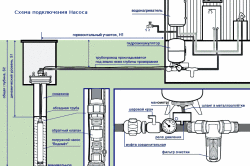
Scheme for determining the height of the pump.
Initial data for the well:
- the total depth is 100 m;
- dynamic water level - 70 m;
- the water static level is 75 m;
- water well diameter is 133 mm;
- flow rate is 3 m³/h;
- filter installation depth - 95 m;
- the equipment control unit is located at a distance of 25 m from the well;
- from the well to the entrance to the house, the distance is 20 m;
- a head is used to design the wellhead;
- the highest point for water intake is 8 m from the ground surface (3rd floor of the house);
- power is supplied from a 220 V network, the system is used single-phase, there is a possibility of drawdowns up to 190 V.
The selection of a pump for a well is carried out in this way:
- First, it is necessary to take into account the number of draw-off points with an allowable flow rate limit of 2.6 m³ / h. This amounts to 5-6 cranes open at the same time, the performance of which is average. Even for a large house, this amount is enough.
- The depth for installing the pump in the well is 72 m.
- For the consumer, a comfortable pressure at the highest point should be 2.5 bar. If we take into account the pressure loss during the rise of 1 bar, then a value of 1.5 for the top point is quite acceptable.
- For the riser pipe, the total length in this case will be 92 m, and for the supply cable to the control equipment panel, the length is 97 m.
- The diameter of the cable is 5 mm, its length is - 72 m + 2 m + 4 * 2 m (for cable loops) = 82 m.
- For water pipe for plastic, the diameter is best taken to be 40 mm, while the total loss will be approximately 4 m if the flow velocity is 0.8 m/s.
- Losses during the operation of the filters will be approximately 10 m, that is, about 1 bar.
- The required total head is H=1.5*10.2+70+(10+4) = 99 m.
What pumping equipment should be?
Taking into account all the above data, the well can be equipped with the following pumping equipment:
- Pump for 1.1 kW, power cable for 4 * 6 m³, while the voltage loss will be 2%.
- Pump for 1.5 kW, power cable for 4 * 6 m³, voltage loss will be 3.1%.
- 1.5 kW pump, 3 * 6 m³ power cable, voltage loss will be 2.9% along the entire length.
- Pump for 1.4 kW, power cable for 3 * 6 m³, loss in length will be 2.7%.
For the presented system, it is best to take a 150-liter accumulator for the first 3 options. At home, it is recommended to install a voltage regulator of 5 kW.
The choice of a pump for a well for water is a responsible process. Not only the characteristics of the pumping equipment itself are taken into account, but also numerous parameters. This is the length of the cable, the presence of a hydraulic accumulator and other elements of the system. During the selection, attention should be paid to the flow of water for the house and the site. Only in this case, the pump can be considered fully suitable for a particular well.








